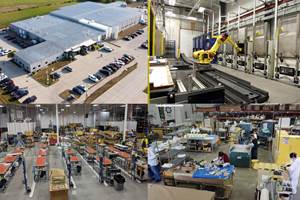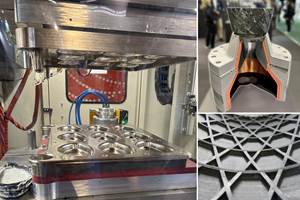Composite Braiding awarded for TPC twin track cantilever support
Railway infrastructure cuts weight by 84%, carbon emissions by 80% and installation time by 50% while automated process offers ≥90% lower labor costs, waste and energy use versus traditional composites manufacturing.
Source (All Images) | Composite Braiding
(Derby, U.K.) has been selected by as regional winners of the 2025 European Railway Clusters Initiative (ERCI) Innovation Awards for its sustainable thermoplastic composite Twin Track Cantilever that supports overhead line equipment for electrified railways.
Weighing just 277 kilograms, the structure reduces weight by 84% and carbon footprint by 80% versus steel supports. It is not only fully recyclable but can reportedly be installed in 15 minutes, reducing installation time by 50% as well as the need for lifting equipment, heavy goods transportation and service roads. Its lightweight also significantly reduces the amount of concrete needed for the structure’s foundations.
“This award recognizes our innovative work as part of the ,” says Composites Braiding general manager, Steve Barbour. “Described by industry experts as ‘game-changing,’ this is the kind of innovation that can transform infrastructure delivery.” The Clean Futures Accelerator is a program within Catapult Connected Places, part of The Innovate UK Catapult Network.
Reporter Lisa Baker explained in a article that steel cantilevers across the U.K.’s rail network number in the tens of thousands. Composite Braiding’s technology has the potential to considerably reduce the carbon footprint of the sector — a critical step for the U.K. to reach its target of net-zero railways by 2050.
“With our manufacturing capabilities, we combine fibers like carbon, glass and basalt with thermoplastics to create advanced composites quickly and at scale,” says Composite Braiding’s technical director, Alastair Barnett. “This fully automated process can reduce labor costs by 90%, industrial waste by 97% and uses 95% less energy that traditional composites manufacturing. We believe that our new lightweight cantilever design is the next step in sustainable rail infrastructure and, once scaled, can truly help to move the needle toward a low-carbon, cost-effective rail network for the future.”
As reported by , Composite Braiding’s lead development engineer, Guy Lawrence, explained the innovative design:
“We had one simple aim — to show that composite rail infrastructure is not just a viable alternative to steel, but brings substantial mechanical, economic and environmental benefits. Our main driver was mass reduction, which ultimately leads to lower installed costs per unit, improved worker safety and significantly reduced installation time.
“Our unique ability to easily adapt product designs means each unit can be tailored mechanically and aesthetically for its given application, while our in-house production methodology enables low-cost, high-volume production of high-performance composites that is repeatable, predictable and easily scalable. By using thermoplastic composites, we can manufacture rail infrastructure that is truly sustainable: low waste, low energy usage, recyclable and repairable.”
Composites Braiding notes that large structural components are ubiquitous in the rail industry, both in infrastructure and rolling stock. That’s where its braiding equipment generates value, able to produce large recyclable components from carbon, glass and/or basalt fiber, combined with sustainable thermoplastics. It can produce tubes and beams of almost any shape that significantly reduce weight and CO2 emissions.
The company thanks Connected Places Catapult, BCIMO and Coventry University for their support through the Clean Futures Accelerator and its in-house Composite Braiding team for succeeding in this achievement.
Related Content
MFFD longitudinal seams welded, world's largest CFRTP fuselage successfully completed
Fraunhofer IFAM and partners have completed left and right welds connecting the upper and lower fuselage halves and sent the 8×4-meter full-scale section to ZAL for integration with a cabin crown module and testing.
Read MorePlant tour: Sekisui Aerospace, Orange City, Iowa, Renton and Sumner, Wash., U.S.
Veteran composites sites use kaizen and innovation culture to expand thermoplastic serial production, 4.0 digitization and new technology for diversified new markets.
Read MoreJEC World 2024 highlights: Thermoplastic composites, CMC and novel processes
CW senior technical editor Ginger Gardiner discusses some of the developments and demonstrators shown at the industry’s largest composites exhibition and conference.
Read MoreCombining multifunctional thermoplastic composites, additive manufacturing for next-gen airframe structures
The DOMMINIO project combines AFP with 3D printed gyroid cores, embedded SHM sensors and smart materials for induction-driven disassembly of parts at end of life.
Read MoreRead Next
Hitachi Rail chooses Roboze printers, materials including carbon fiber/PEEK for railway spare parts
The Roboze ARGO 500 will be used at Hitachi Rail factories in Naples, Italy and Maryland, U.S. to reduce cost and delivery times for prototypes and spare parts.
Read MoreComposites to target indirection emissions reduction in U.K. rail sector
Composite Braiding’s Steve Barbour suggests ways to further decarbonize the U.K. rail industry through increased composites adoption.
Read MoreUltrasonic welding for in-space manufacturing of CFRTP
Agile Ultrasonics and NASA trial robotic-compatible carbon fiber-reinforced thermoplastic ultrasonic welding technology for space structures.
Read More












